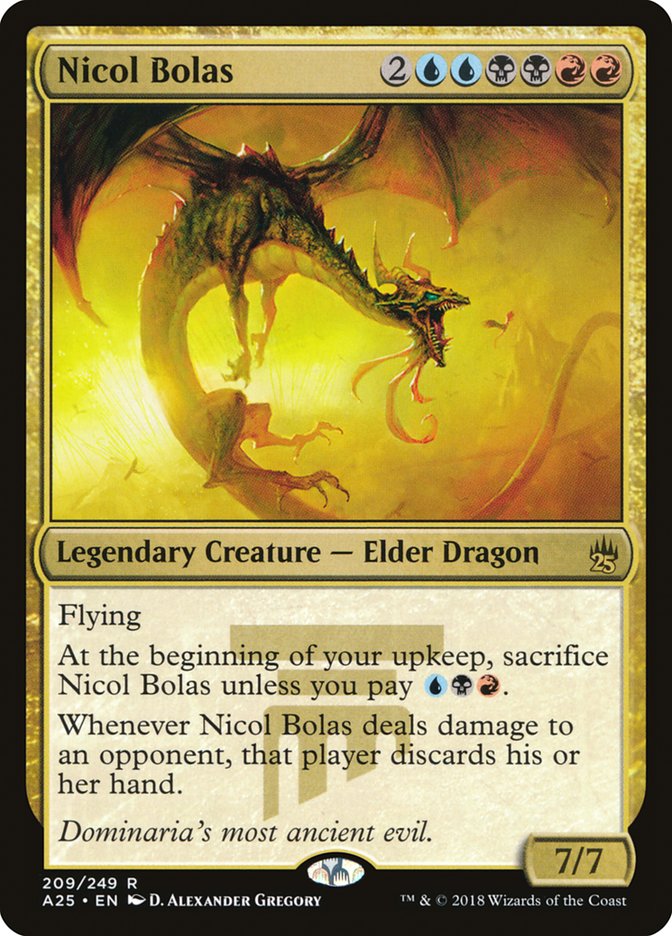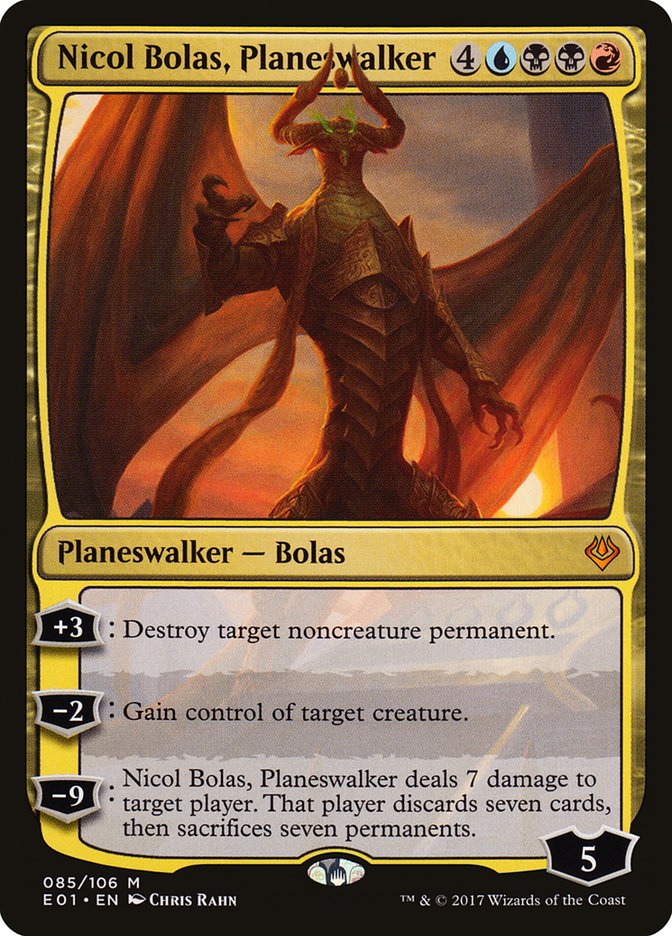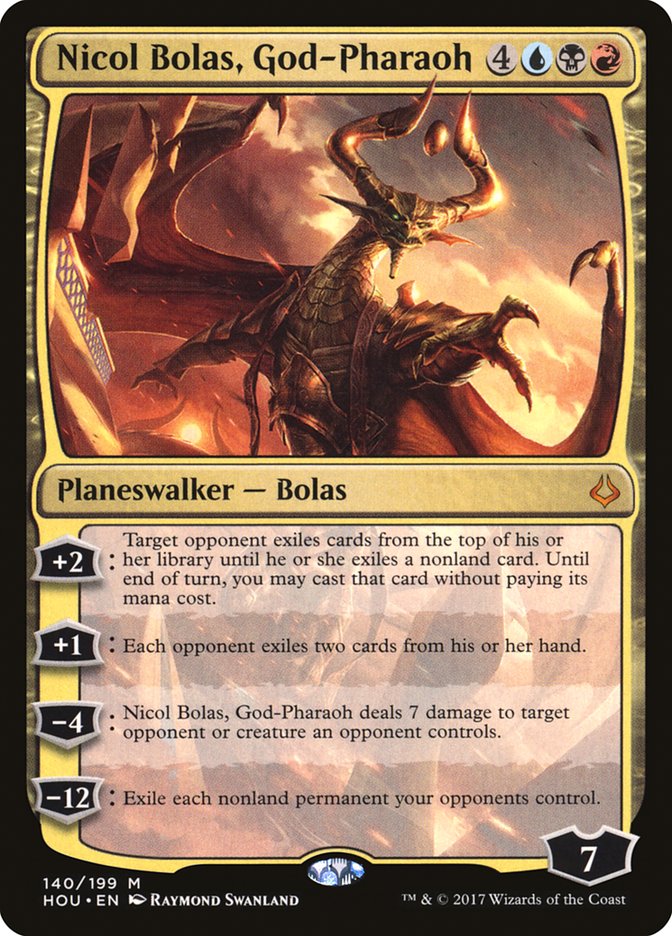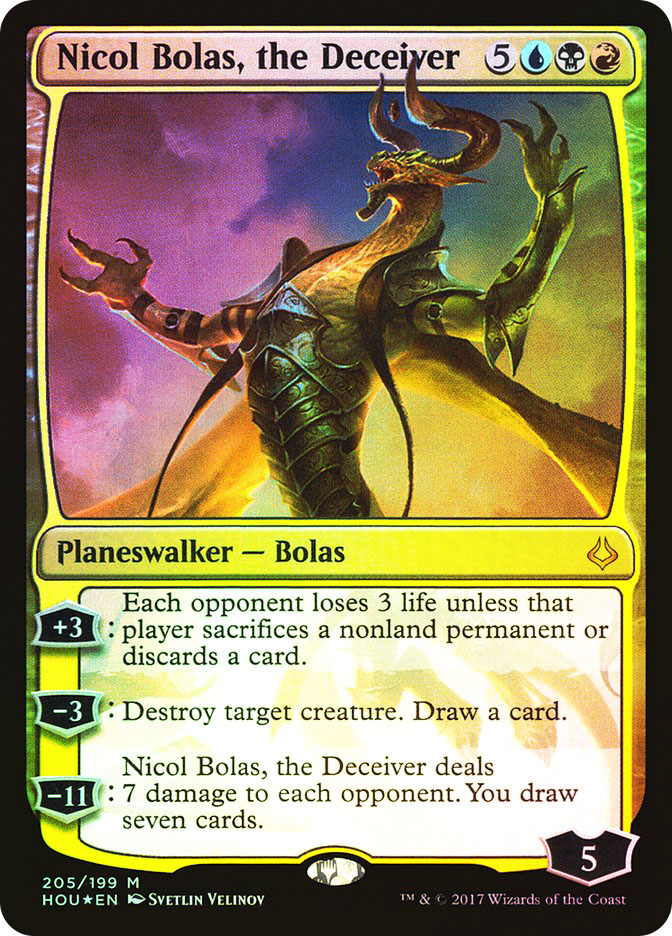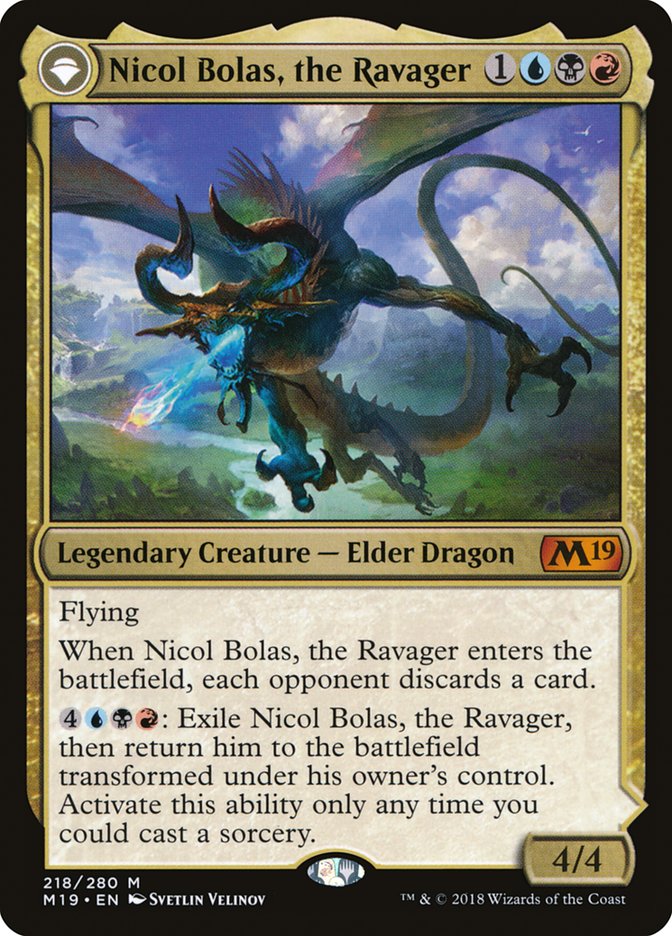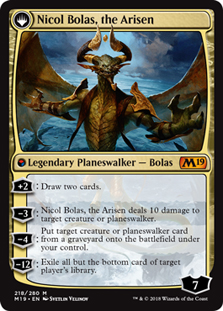He was one of the original five Elder Dragon legends, one of the characters
that laid the earliest bricks in the foundations of Commander. He has since
become the greatest villain in the multiverse. He has disciples. He has
slaves. And he has many enemies to justly fear him.
He is, of course, Nicol Bolas.
From his original (and appropriate) appearance in Legends to his
most recent in Core Set 2019, he has stricken fear into the hearts
of players in both the guise of a creature and a planeswalker. He is big,
he is expensive, and his abilities are splashy. Today we’re going to talk
about how every version of everyone’s favorite nemesis might fit into your
Commander decks-and what you might do if you know you’ll be facing him down
across the table. We’ll go through them chronologically.
Nicol Bolas
Eight mana is quite a bit these days for a flying 7/7, even with a good
ability. It’s not the cost that is prohibitive, however; it’s the upkeep,
forcing you to pay UBR or sacrifice him. I imagine the original idea behind
the upkeep was that you didn’t want players to be able to reanimate him
early, especially with his rather powerful ability-if Nicol Bolas deals
damage to a player, they discard their hand. Talk about your
beatings. Among the original Elder Dragons, the triggered ability makes it
easily the strongest. And we’ll set aside the idea that any Bolas card is
nice. In all his incarnations, he’s Grixis through and through.
As a commander, you’ll need to provide some ramp and mana rocks in order to
get and keep Nicol Bolas going at a reasonable pace. The most relevant
abilities to give him are haste and trample. You could certainly provide
that in one card with Akroma’s Memorial (along with several other nice
abilities). Given his mana cost, you’re not going to be able to cast him
that many times over the course of a game, so you’ll have to pick your
spots. Another Grixis nightmare like Thraximundar as 1 of 99 could be the
kind of thing to eat spot removal so that you cast Nicol Bolas on a
subsequent turn and have a clear path. For the most part, you really only
have to hit an opponent once to get the big benefit and make them a lesser
factor so that you can go after someone else.
Using him in a deck with a different commander screams using reanimation.
If you have a sacrifice outlet (and you’re in black and red, so those are
easy to come by), Dawn of the Dead provides a recurring nightmare (see what
I did there?) of Nicol Bolas face-smashing. It also gets you around the
awkwardness of the upkeep cost.
If you’re going to stare down Nicol Bolas, you’ll simply want to take every
possible measure to not get hit by him. Short of the hostile environment
for creatures we’ll discuss momentarily, you can keep him from hitting you
with Fog effects, especially those that make the creature not untap next
turn-like Tangle. A favorite tack of mine is Crackdown, keeping all big
nonwhite creatures tapped down. There’s also Marble Titan, but that’s going
to affect you as well. If you want to get really wild, try Energy Storm.
Maze of Ith and Mystifying Maze work for some kind of repeatability.
Nicol Bolas, Planeswalker
First appearing in Conflux and then being reprinted in Magic 2013, this was our first look at a post-spark Nicol Bolas.
The planeswalker is straight up meaner than the creature. It has one of the
worst mana cost-to-loyalty counter ratios, but makes up for it by having a
+3 for his first ability, which destroys a noncreature permanent. In fact,
the only non-Bolas planeswalker to have a +3 is Nissa, Nature’s Artisan.
You’ll still need a three activations before getting off the devastating
third ability, doming a player for seven, having them discard seven, and
sacrificing seven permanents. The good news is that you’ll still have two
loyalty counters left to start the process over with.
The most viable way of making Nicol Bolas, Planeswalker work in a deck is
to have it full of death and destruction. You want to not just be able to
cast him, but to use him repeatedly. The best way to do that is to create
an environment hostile to creatures. The tried-and-true way is via lots of
Damnation effects, but you can also go outside the box.
Two extremely old school cards that are good at this are Lethal Vapors and
Tainted Aether. Few cards are more hostile than Lethal Vapors, which
destroys a creature when it enters the battlefield. Any player can get rid
of it-by skipping their next turn. You end up in a giant game of chicken to
see who’s going to flinch. Of course, you know it’s coming, so you fill
your deck with indestructible creatures (Seraph of the Suns), creatures
that regenerate (Child of Gaea), or creatures that don’t start out as
creatures (Chimeric Egg). Tainted Aether doesn’t get rid of anything in
particular, but when a player is out of creatures, they’ll have to
sacrifice a land to get a creature onto the battlefield. It’s particularly
effective at short-circuiting mass creature creation, like with Storm Herd,
or even with Ghave, Guru of Spores, whose Saprolings now come at a very
high price. Another neat way to limit the creature rush is through
Spreading Plague. It doesn’t destroy the creature that just entered the
battlefield, but it destroys everything else that shares a color with it,
meaning that unless the creature has haste, your planeswalkers are quite a
bit safer.
You don’t need to do much more than you’re already doing to ward off this
Bolas. You’re prepared to have your creatures destroyed at some point
anyway-either you regrow them or just make more. The best way to keep from
being a victim of Bolas is to make your creatures (and eventually yourself)
untargetable with hexproof. The classic examples include Privileged
Position and Asceticism, which also nicely offers regeneration. Archetype
of Endurance is quite expensive at eight mana, but does the same and makes
other players not capable of having the ability. From Dominaria
comes the one which does it all for you, Shalai, Voice of Plenty. You, your
planeswalkers, and your creatures all have hexproof, and it only costs 3W.
Nicol Bolas, God-Pharaoh
Coming from Hour of Devastation at a relatively cheap seven mana,
this card could honestly just have the first two abilities and I’d still
play it. The third isn’t particularly relevant for commander, although I
imagine you might get into a few scrapes in which it’d be useful, and the
ultimate is just a game winner. But then again, it costs twelve loyalty
counters to activate.
I’d actually be hard pressed to not just use anything other than the +2
ability to cast things off of my opponents’ libraries. You’ll exile lands
and get to the good stuff. And if you don’t really want to cast the spell,
you can just leave it exiled. There are a few creatures, like persisters
Woodfall Primus and Puppeteer Clique, that are probably better off not
letting the player have access to anymore. Casting your opponent’s
Sepulchral Primordial, on the other hand, is well worth it. Or Blightteel
Colossus. That’s always nice.
The EV of the +1 ability to make all opponents exile two cards from their
hands is reasonably high in a mid- or late-game situation in which those
hands might not be all that full. You’re getting a six or eight card
advantage, rounded down some for the fact that they get to choose them.
Still, they’re exiled, not discarded, which beefs up the value. The +1
ability simply doesn’t look quite as good because the +2 ability is there,
but there are certainly situations in which it’ll be better.
As far as seeing the God-Pharaoh hit the opposite side of the table, you’ll
again consider doing some things you might already want to do. If your
environment is especially heavy with other people gaining control of your
stuff (or taking it out of your library with Bribery), you’re likely
playing Brooding Saurian or Homeward Path anyway. If you aren’t and were
just thinking about it, think about it harder. Obviously, once you see
God-Pharaoh on the battlefield, keep that extra land in your hand instead
of reflexively dropping it. The move will likely save a card that you
really want to cast.
Nicol Bolas, the Deceiver
The Hour of Devastation-mate of our friend the God-Pharaoh, this
Bolas planeswalker is less good. Back at that onerous eight mana cost, you
don’t get much value until the ultimate. Losing three life isn’t likely to
be a concern for most of your opponents, so all you’re doing is plussing
up-unless you’re also running Exquisite Blood or Mindcrank. “Destroy target
creature. Draw a card” sounds really nice until you realize that you can
only do it once before you need to add more loyalty counters. Additionally,
if the target becomes illegal after you activate the ability (like the
player sacrifices it), you don’t get to draw the card. Boo-urns. Finally,
for eleven loyalty counters, and really not trying to be super greedy here,
I want more than filling up my hand.
If I’m facing Nicol Bolas, the Deceiver, I’m saying dismissive things like
“I thought you were supposed to be a badass.” I’m usually in a position in
which I’d like to sacrifice something I have so that I can get a neat
trigger off of it (thank you, Solemn Simulacrum) or get it back onto the
battlefield (thank you, Masked Admirers). All in all, this is the weakest
of the Bolas cards.
Nicol Bolas, the Ravager and Nicol Bolas, the Arisen
Thematically, I love seeing that this card is an Elder Dragon that can
ascend to planeswalkerhood. A real value at four mana for a 4/4 flyer that
costs every opponent a card, it might be fine if you never get to transform
it. By paying the more Bolas-like cost of 4UBR, however, the pedal has hit
the metal. It’s had to survive as a creature to be able to transform, so
coming with a beefy seven loyalty counters is already strong. Three of its
four abilities are even stronger.
You could certainly be content at doing nothing other than draw two cards
on each of your turns. So long as no one can and is willing to deal more
than eight damage to it, you’re fine. Obviously, they can’t let you get to
twelve or more counters, so if you occasionally use the -4 ability to
reanimate a creature or planeswalker, they’ll get less twitchy. And you’ll
have some cool creatures. Just promise that you’re not going for the big
bang, and maybe they’ll let you go-just don’t go back on that deal if you
make it.
If someone else is playing Nicol Bolas, the Ravager, do your best to kill
it before they can transform it. There’s nothing (other than that ultimate)
that will directly hurt you if it does, but it’s the indirect hurt (the
draw) which matters. Once again, if they’re going to borrow your creatures,
just take them back with Homeward Path and thank them for the opportunity.
Otherwise, slam your creatures right into this Bolas’ face, because if
they’re going long, you’re in huge trouble.
The Nicol Bolas cards are like Commander in microcosm. They’re almost all
exceedingly mana-intensive and have huge effects. You wouldn’t expect the
multiverse’s most iconic villain to throw anything other than haymakers,
now would you?
A New Feature
You do some things for a while and even if there’s nothing specifically
wrong with the thing, it’s time for a change. Such is the fate of Deck
Without Comment. You’ll still be able to check out all of my decks in our
cool Deck List Database (always linked in the footer here), but we’re going
to dedicate the space to something a little different.
Reader mailbag articles are reasonably popular and generate discussion
about community issues and just cool stuff related to our shared
obsessions. I’ve historically done them quasi-quarterly and will return to
them from time to time, but it seems like answering a question from the
community every week is the right call. So we’re going to do it right in
this very spot. I’ve reserved
a spot on the official Commander forums
to park questions, so fire away.
This week’s Question of the Week comes from multiple sources over multiple
years. I referenced it a bit in the
Commander panel I did with Gavin Verhey and Bennie Smith at SCG Con
, but since it comes up from time to time, it’s a great one to kick off
with.
“How does someone get to be on the Commander Rules Committee?”
The short answer is “be the person we look at and ask ourselves why you’re
not already on the RC.” The longer answer is, as you might expect, far more
nuanced.
We’re not actively seeking to add a member, but if the right person comes
along we’d jump at the chance to ask them to join. The right person is
well-enough known in Magic and/or Commander circles, is tapped into the
community, has a keen mind for both the game and the format which runs
alongside their love for both, and understands how to function as part of a
team. Having a good sense of humor is a plus.
One of the things that makes the RC work relatively smoothly is that we all
trust each other a great deal. This doesn’t mean we have to completely
agree on everything (we are pretty far from living in an echo chamber), but
we have to trust that the other person has the best interest of the format
in mind. When we discuss banning or unbanning a card or a rules change, we
don’t worry that there are hidden agendas. This is an incredibly effective
environment for coming to good, reasonable decisions. Obviously, it helps
that we’re long-time friends and were all friends and colleagues before the
RC ever existed, but being outside the “inner circle” is probably a bonus
at this point.
The biggest thing is that a new RC member would need to share the vision.
Again, we’re not talking about 100% agreement, but having a sufficient
amount of philosophical overlap. Being a cEDH player wouldn’t automatically
disqualify you-but you’d also have to be a not-cEDH player as well, one who
appreciates the other side of the coin.
Finally, and please don’t take this in the spirit other than it’s intended
since it’s a hope, not a prerequisite: some diversity would be awesome. The
four of us are middle-aged (or older; I now qualify to live in one of those
Active Adult communities) upper-middle class white dudes. It would be nice
to have eyes that have seen different things, and minds shaped by different
experiences.
So who is the person we’d add to the Rules Committee? The one we simply
can’t say no to.
Check out our comprehensive Deck List Database for lists of all my decks:
SIGNATURE DECKS
Purple Hippos and Maro Sorcerers
;
Kresh Into the Red Zone
;
Halloween with Karador
;
Dreaming of Intet
;
You Did This to Yourself
.
THE CHROMATIC PROJECT
Mono-Color
Heliod, God of Enchantments
;
Thassa, God of Merfolk
;
Erebos and the Halls Of The Dead
;
Forge of Purphoros
;
Nylea of the Woodland Realm
;
Karn
Evil No. 9.
Guilds
Lavinia Blinks
;
Obzedat, Ghost Killer
;
Aurelia Goes to War
;
Trostani and Her Angels
;
Lazav, Shapeshifting Mastermind
;
Zegana and a Dice Bag
;
Rakdos Reimagined
;
Glissa, Glissa
;
Ruric Thar and His Beastly Fight Club
;
Gisa and Geralf Together Forever
.
Shards and Wedges
Adun’s Toolbox
;
Angry, Angry Dinos
;
Animar’s Swarm
;
Borrowing Stuff at Cutlass Point
;
Ikra and Kydele
;
Karrthus, Who Rains Fire From The Sky
;
Demons of Kaalia
;
Merieke’s Esper Dragons
;
Nath of the Value Leaf
;
Queen Marchesa, Long May She Reign
;
Rith’s Tokens
;
The Mill-Meoplasm
;
The Altar of Thraximundar
;
The Threat of Yasova
;
Zombies of Tresserhorn
.
Four Color
Yidris: Money for Nothing, Cards for Free
;
Saskia Unyielding
;
Breya Reshaped
;
Yidris Rotisserie Draft Deck
.
Five-Color
Partners
Tana and Kydele
;
Kynaios and Tiro
;
Ikra and Kydele
.
THE DO-OVER PROJECT
Adun Oakenshield Do-Over
;
Animar Do-Over
;
Glissa Do-Over
;
Karador Do-Over
;
Karador Version 3
;
Karrthus Do-Over
;
Kresh Do-Over
;
Steam-Powered Merieke
Do-Over;
Lord of Tresserhorn Do-Over
;
Mimeoplasm Do-Over
;
Phelddagrif Do-Over
;
Rith Do-Over
;
Ruhan Do-Over
.
If you’d like to follow the adventures of my Monday Night RPG group (in a
campaign that’s been alive since 1987) which is just beginning the saga The Lost Cities of Nevinor, ask for an invitation to the Facebook
group “Sheldon Menery’s
Monday Night Gamers.”


